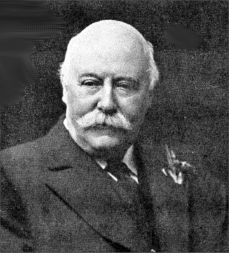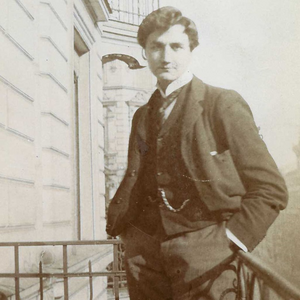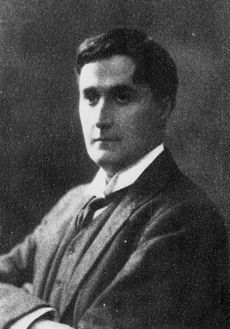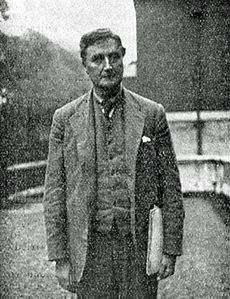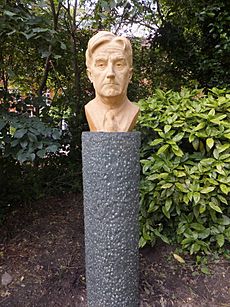Ralph Vaughan Williams facts for kids
Ralph Vaughan Williams, often called RVW, was a famous English composer. He was born on October 12, 1872, and lived until August 26, 1958. He wrote many different kinds of music, including operas, ballets, and pieces for orchestras, like his nine symphonies.
Vaughan Williams was greatly inspired by old English music from the Tudor period and by traditional English folk songs. His music helped British music move away from the German style that was popular in the 1800s.
He came from a wealthy family and believed that music should be for everyone. He wrote many pieces for amateur musicians and students to perform. He developed his unique musical style a bit later in life, in his late thirties. Studying with the French composer Maurice Ravel helped him make his music clearer and less influenced by German styles.
Vaughan Williams is known for his wide range of musical moods, from powerful and stormy to peaceful and mysterious. Some of his most famous works are Fantasia on a Theme by Thomas Tallis (1910) and The Lark Ascending (1914). He also wrote many hymns and folk song arrangements.
Two big events deeply affected his life. Serving in the army during World War I had a lasting emotional impact. Later in life, he married for a second time and continued composing actively into his old age. He wrote his last symphony just months before he passed away at 85. His music is still very popular in British concerts today.
Contents
Life and Music Journey
Early Life and Family
Ralph Vaughan Williams was born in Down Ampney, Gloucestershire, England. His father was a vicar, a type of church leader, who sadly died when Ralph was only two years old. His mother, Margaret, then moved the family to her childhood home, Leith Hill Place, in Wotton, Surrey.
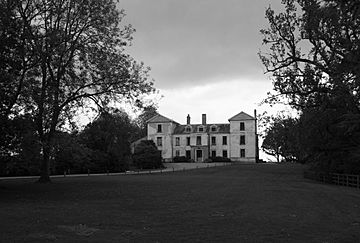
Ralph's family was very open-minded. When he asked his mother about Charles Darwin's famous book On the Origin of Species, she told him not to worry, saying that whether God made the world in six days or it took longer, it was still amazing.
Ralph started piano lessons at age five with his aunt. He showed musical talent early on, composing his first short piano piece, "The Robin's Nest," that same year. He preferred the violin and started lessons for it the next year. At eight, he even took a music course by mail from Edinburgh University.
School Days and Beliefs
In 1883, at age 11, Ralph went to a boarding school called Field House. He was generally happy there, though he was surprised by the snobbery and conservative views of some other students. He then moved to Charterhouse, a public school, in 1887. He did well in his studies and sports, and the school encouraged his music. He even organized a concert there, playing violin in one of his own pieces.
While at Charterhouse, Ralph became less religious. He later described himself as a "cheerful agnostic" (someone who isn't sure if God exists). However, he still went to church to avoid upsetting his family. He always loved the beautiful language of the Bible, which remained important to him throughout his life.
Music College and University
In 1890, Vaughan Williams started studying at the Royal College of Music (RCM) in London. He learned harmony, organ, and composition. His first composition teacher was Hubert Parry.
His family wanted him to get a university education, so in 1892, he went to Trinity College, Cambridge, to study music and history. He made many friends there, including famous philosophers and historians. He felt a bit outshone by some of his friends but learned a lot from them.
After Cambridge, he returned to the RCM. His new composition teacher was Charles Villiers Stanford. They often disagreed, as Stanford was quite traditional, and Vaughan Williams wanted to explore new sounds. But Stanford recognized Ralph's talent and helped him improve his music.
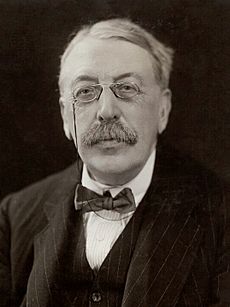
At the RCM, he also met Gustav Holst, who became his lifelong friend. They would often play their new music for each other and give honest feedback. Vaughan Williams said that what he learned most from college was from his fellow students, especially Holst.
Early Career and Folk Music
Vaughan Williams had some private money, but he also worked to earn more. He was a church organist and choirmaster for a few years, though he didn't enjoy it much. This experience with choirs was very useful later on.
In 1897, he married Adeline Fisher. They spent their honeymoon in Berlin, where he studied with another composer, Max Bruch. They then settled in London.
In 1902, his song "Linden Lea" was published, becoming his first printed work. He also wrote articles, edited music, and taught adult education classes. From 1904 to 1906, he was the music editor for a new hymn book called The English Hymnal. He said that working on this book was a better musical education than any other studies. He also helped start the amateur Leith Hill Musical Festival in 1905 and was its main conductor for many years.
Around 1903, Vaughan Williams began collecting folk songs. He traveled the English countryside, writing down traditional songs that people sang. He published these collections, saving many songs that might have been lost. These folk songs, with their special musical scales (called modes), greatly influenced his own compositions.
Studying with Ravel and Rising Fame
Vaughan Williams felt he needed to improve his composing skills. He went to Paris in 1907–1908 to study with the famous French composer Maurice Ravel. Ravel was a strict teacher, but he helped Vaughan Williams make his music lighter and clearer, moving away from heavier German influences.

After returning from Paris, Vaughan Williams became more and more known in British music. In 1910, two of his major works premiered: the Fantasia on a Theme by Thomas Tallis and A Sea Symphony. Critics loved them. One wrote that the fantasia "seems to lift one into some unknown region of musical thought and feeling."
His next big work was A London Symphony (1914). In the same year, he wrote The Lark Ascending for violin and piano.
Even though he was 42 when World War I started in 1914, Vaughan Williams volunteered for the army. He drove ambulance wagons in France and Greece. This was very hard work, and he lost many friends, including the composer George Butterworth. The constant noise of the guns damaged his hearing, which affected him later in life. After the war, he was a music director for the British army until 1919.
Between the Wars
Vaughan Williams stopped composing during the war. After returning home, it took him a while to start writing new music. In 1919, he began teaching composition at the RCM, where he stayed for 20 years. He also became the conductor of the Bach Choir in London.
In 1922, he completed a major new work, A Pastoral Symphony. Throughout the 1920s, he continued to compose, conduct, and teach. He wrote many pieces, including his Mass in G minor (1922) and the operas Hugh the Drover and Sir John in Love.
His wife, Adeline, became very ill with arthritis, so in 1929, they moved from London to a house called "The White Gates" in Dorking. He missed London, but Dorking was a good compromise.
In the 1930s, Vaughan Williams became a leading figure in British music, especially after the deaths of other great composers like Edward Elgar and his friend Gustav Holst. Holst's death was a huge loss for him.
Some of his music from the 1930s, like the ballet Job: A Masque for Dancing (1930) and the Fourth Symphony (1935), was surprisingly dark and powerful. The Fourth Symphony, written when international tensions were rising, sounded very harsh and strong. He said it was just music, but many felt it captured the troubled mood of the time.
Second World War and Later Life
During World War II, Vaughan Williams helped with civilian war efforts. He helped organize concerts and committees for refugees. In 1940, he wrote his first film score for the movie 49th Parallel.
In 1943, he conducted the premiere of his Fifth Symphony. This symphony had a very peaceful and calm tone, which was a big contrast to his stormy Fourth Symphony. It brought comfort to many during the war.
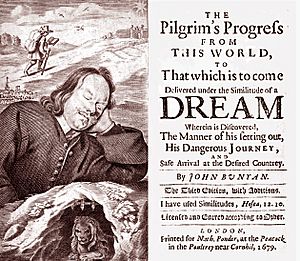
Any idea that the older composer was settling into quiet music was shattered by his Sixth Symphony (1948). This work was described as "one of the most disturbing musical statements of the 20th century," starting with a powerful scream. Its quiet, mysterious ending made many think of a desolate landscape after a war.
In 1951, his wife Adeline passed away. That same year, his last opera, The Pilgrim's Progress, was performed. He had worked on this opera, based on a famous religious story, for 45 years. It wasn't a huge success with the public, but Vaughan Williams didn't mind, saying, "it's what I meant, and there it is."
Final Years and Legacy
In 1953, Vaughan Williams married Ursula Wood. They moved to London, and he became more active in public life, supporting young composers and new music. He traveled to Europe and the US, where he was warmly welcomed.
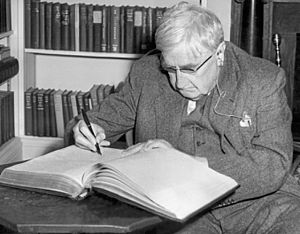
In his last years, he composed three more symphonies. The Seventh Symphony (1952) used music he wrote for a film about Antarctica. The Eighth Symphony (1956) was shorter and more lighthearted. His Ninth Symphony (1957), completed shortly before his death, had a more serious and thoughtful mood.
Ralph Vaughan Williams died suddenly on August 26, 1958, at the age of 85. His ashes were buried in Westminster Abbey, near other famous composers.
Vaughan Williams's Music Style
Vaughan Williams's music has a very unique sound. It mixes the old-fashioned sounds of folk songs with the clearer styles he learned from Ravel. His music often has strong melodies. Many people describe his music as "visionary," meaning it feels like it comes from a deep, imaginative place.
He wrote a lot of music for voices, including songs, operas, and big choral pieces for choirs. He didn't write as much for small groups of instruments (chamber music). Some of his most special works don't fit into usual categories, like Serenade to Music for 16 singers and orchestra.
Critics have noted that his music often shows two main moods: one is calm and dream-like, and the other is strong and sometimes dark. People often love the peaceful beauty of pieces like the Tallis Fantasia and The Lark Ascending. But in his darker moods, like in the Fourth and Sixth Symphonies, his music can be very powerful and intense.
His Symphonies
Vaughan Williams is best known for his nine symphonies. A symphony is a long piece of music for an orchestra. He wrote his first symphony when he was 38, and they cover almost 50 years of his life. Each of his symphonies is different in its structure and mood.
Early Symphonies (1910–1922)
His first three symphonies have titles instead of just numbers, and they tell a bit of a story.
A Sea Symphony (1910) is unique because it includes a full choir singing throughout the piece. It's very long, about 80 minutes, and has some strong, modern sounds for its time.
A London Symphony (1911–1913) is mostly about the feeling of London, rather than showing specific pictures. Vaughan Williams said it was "by a Londoner" and should be judged as pure music. However, it does have sounds of the city, like street music, the calls of sellers, and the chimes of Big Ben. Some people also hear hints of social problems in the music. Vaughan Williams later said this was his favorite symphony.
The Pastoral Symphony (1921) is the last of this group. It's mostly for orchestra, but the end has a wordless solo voice. Despite its title, it's not a simple, peaceful English countryside scene. It actually reflects the French countryside damaged by war, and many hear a sad, memorial-like quality in it.
Middle Symphonies (1935–1948)
These three symphonies are purely for orchestra and follow a more traditional structure.
The Fourth Symphony (1935) surprised everyone with its harsh, clashing sounds. It was very different from his previous peaceful symphony. The composer insisted it had no specific story, but its strong, sometimes violent, mood made many think of the growing tensions in the world before World War II.
The Fifth Symphony (1943) was a complete contrast. Vaughan Williams used some music he had written for his opera The Pilgrim's Progress to create this symphony. It is generally calm and peaceful, and it was especially loved for the comfort it brought during World War II.
With the Sixth Symphony (1948), Vaughan Williams surprised audiences again. Many thought his Fifth Symphony, written when he was 70, would be his last peaceful work. But the Sixth is turbulent and troubled. Its very quiet, long ending puzzled many listeners, but it's considered one of his most powerful and unsettling works.
Late Symphonies (1952–1957)
The Seventh Symphony (1952) came from music he wrote for the film Scott of the Antarctic. It has five movements and includes wordless singing and even a wind machine to create the sounds of the Antarctic. Some critics debate if it's a true symphony or more like a film score.
The Eighth Symphony (1956) is shorter and generally lighthearted, even though it's in a minor key. It uses a smaller orchestra but has a very large percussion section, with many different instruments. It was very popular when it first came out.
His final symphony, the Ninth Symphony, was finished in late 1957. It uses a large orchestra, including saxophones. Its mood is more serious and thoughtful than the Eighth. It took some time for critics to fully appreciate this work.
Other Orchestral Music
Besides his symphonies, Vaughan Williams wrote over 30 other pieces for orchestra. Two of his most popular works are the Fantasia on a Theme by Thomas Tallis (1910) and The Lark Ascending (1914, orchestrated 1920). Other well-known pieces include the English Folk Song Suite (1923) and the Fantasia on Greensleeves (1934).
He also wrote four concertos (pieces for a solo instrument and orchestra) for violin, piano, oboe, and tuba. He composed music for 11 films, starting with 49th Parallel in 1941.
Vocal Music
Vaughan Williams loved poetry, and he believed the human voice was the "oldest and greatest of musical instruments."
Songs
He set over 80 poems to music for voice and piano. Many of these songs are still popular, like "Linden Lea" (1902) and "Silent Noon" (1904). His song cycles, like Songs of Travel and On Wenlock Edge, are also very famous. His songs are often described as simple and natural, with a strong, outdoor feeling.
Choral Music

Even though he was agnostic, Vaughan Williams wrote many pieces for church services. His two most famous hymn tunes are "Down Ampney" and "Sine nomine" ("For All the Saints"). He also wrote larger church works like the Mass in G minor (1920–1921).
For concerts, he wrote many choral works, both secular (non-religious) and religious. His oratorio Sancta Civitas (1923–1925) was his favorite choral work. The Dona Nobis Pacem (1936) is a powerful anti-war piece that mixes words from poems and the Latin mass.
Stage Works
Vaughan Williams wrote several works for the stage, including operas and ballets. He often used different names for them, like "masque" or "morality play."
His ballet Job: A Masque for Dancing (1930) was a big success. It was inspired by William Blake's famous pictures for the Book of Job from the Bible. The music is considered one of his greatest achievements and is often played in concerts like a symphony.

His one-act opera Riders to the Sea (1925–1931) is considered one of his finest works. It's based on a play about a family tragedy in an Irish fishing village. The music is very subtle and moving, with sounds that remind you of the sea.
Recordings and Influence
Vaughan Williams himself conducted a few recordings of his music. In the 1950s, his music was well-represented in record stores. Today, almost all of his major works have been recorded. Many British orchestras and conductors have recorded his music, but also famous international conductors like Leonard Bernstein and André Previn.
After Vaughan Williams died, his style of music became less popular for a while, as composers explored more modern sounds. However, in the 21st century, his music has become very popular again. People have rediscovered his genius and the deep emotions in his work. Many modern musicians have said that Vaughan Williams influenced them.
Cultural Impact
There are several portraits and sculptures of Vaughan Williams in famous places like the Royal College of Music and the National Portrait Gallery. There is also a statue of him in Dorking and a bust in Chelsea Embankment Gardens in London, near where he used to live.
In 1994, a group of fans started the Ralph Vaughan Williams Society to promote his music. They organize concerts and support new recordings of his works.
Images for kids
-
Vaughan Williams lived in Cheyne Walk, Chelsea, from 1905 to 1929
See also
 In Spanish: Ralph Vaughan Williams para niños
In Spanish: Ralph Vaughan Williams para niños


